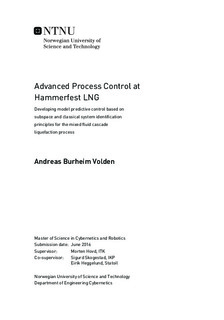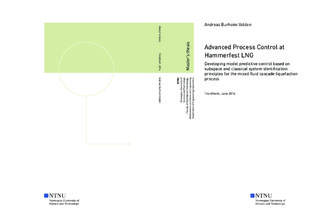| dc.description.abstract | Although it principally resembles a refrigerator, production of LNG is a complex and energy demanding process. At Hammerfest LNG the Statoil/Linde developed mixed fluid cascade process
liquefy natural gas from gaseous to liquid at temperatures at 110 K. From an operational perspective, the process is sensitive to disturbances and demonstrate multivariable phenomena such as interactions. Further, sea water temperature ultimately renders operation of cooling cycle compressors at their constraints. In addition, some control loops suffer from poor closed-loop control. These features outline the motivation behind this study towards more advanced process control.
The MFC process is vast and comprises a complex control structure although primarily based on
single loop controllers. Thus, a necessity to render this project feasible, an initial task was to define the MPC extent in terms of MVs and CVs. By considering findings from previous work on optimization and analysis of the MFC process, the MPC extent was defined to comprise pressure control of the subcooling cycle.
Towards the development of an MPC, a large amount of labour have been invested in the model
identification work. Some initial results were unsatisfactory, and required a thorough investigation as to why identified models consistently scored too low on validation data. The reason behind was found in a feature of the control structure. A split range and selector controller rendered the initial system infeasible for proper identification. Thus, the suggestion MPC extent was altered. New identification experiments returned satisfactory results. Even though, a range of analyses and comparisons were performed to ensure the proposed model s suitability.
Two MPC configurations were developed utilizing two different control systems. Simulations were run for setpoint manipulations of different CVs and disturbances. In terms of constraint handling, both MPC configurations demonstrated superior performance compared to the isolated regulatory layer. Although, there were some aspects regarding time spent to move CVs that need to be investigated further. The isolated regulatory layer outperforms the MPC applications in terms if this aspect for most of the simulations. The direct MPC application is almost consistently slower compared to the supervisory MPC. In terms of setpoint changes for CVs, the supervisory MPC shows promising tight control for accurate priorities.
Since the results are based on simulator data, one would indeed expect some differences between simulator data and plant operational data. However, the D-Spice simulator utilized in thiswork is not expected to possess the accuracy required to demonstrate such results. Optimization is nevertheless a difficult task for this system, and it certainly requires more rigorous modelling. Additionally, the complexity of the control system is not straightforward to handle. This may cause additional issues. In total, these factors rule out the feasibility to provide an unambiguous conclusion. Although, the work carried out in this thesis would hopefully be useful as a starting basis for further development. | en |

